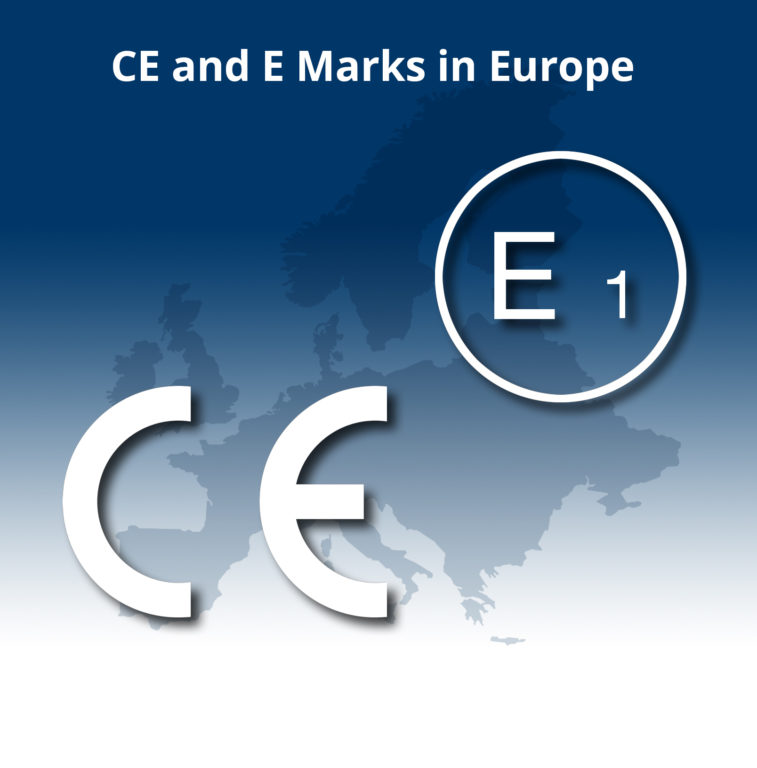This article addresses the applicability of CE and E-marks to automotive electronics, when looking to sell automotive electronics systems into Europe, and how Dana OpenECU products can support customer’s regulatory challenges.
What is CE marking and how does it apply to automotive electronics?
According to https://ec.europa.eu/growth/single-market/ce-marking/ the CE marking indicates a product has “been assessed to meet high safety, health, and environmental protection requirements.” These requirements cover a range of products & potential sources of pollution.
Automotive electronics largely fall into categorical exemptions from CE marking. For example, most automotive electronics do not have operating input or output voltages above 50Vac, or 75Vdc, and therefore are not in scope for the Low Voltage Directive 2014/35/EU. CE marking also includes an EMC directive, 2014/30/EU, which includes a categorical exemption for vehicles/automotive electronics on the basis that there is a more specific directive for the automotive industry.
What is E-marking and how does it apply do automotive electronics?
According to https://www.unece.org/trans/main/wp29/wp29regs0-20.html E-marking is a regulatory process for vehicles, and electronic sub-assemblies, which certifies the product demonstrates a bare minimum of EMC immunity for safety functions, and has EMC emissions below a statutory maximum. Tests on electronic sub-assemblies also check for immunity against transient disturbances common in automotive electrical systems. The level of formality associated with E-marking is significant. Testing related to E-marking must be witnessed by a regulatory body, at a certified lab, to a pre-approved test plan. That testing rigor differs from CE mark requirements, which often simply require a self-certification.
E-marking is the automotive industry specific EMC process which supplants the CE EMC directive according to 2014/30/EU Article 2(3). It is required for all vehicles sold in Europe.
There are two paths available to achieving E-mark, at the discretion of the manufacturer:
- E-marking can be achieved by testing the vehicle as a whole
- E-marking can be achieved by testing each electrical sub-assembly (ESA) and integrating them within their installation guidelines
Both paths require a test plan approved, and testing observed by a notified body. The test plan must identify:
- the immunity related functions (of the ESA or vehicle) related to:
- control of the vehicle
- signaling other road users
- vehicle occupant and road user protection
- the mission profile, and load simulators, which are expected to produce the max EMC emissions
E-mark testing is similar to typical OEM-specified EMC testing, althoughgenerally, the limits of the tests are less stringent than common OEM specifications:
- Radiated emissions (CISPR 12 & 25)
- Radiated immunity (ISO 11451 & ISO 11452)
- Power line transient immunity & emissions (ISO 7637)
How Dana can help customers achieve E-marking and regulatory compliance
Dana helps customers plan for, and execute, E-mark testing on custom controller products and systems containing an OpenECU controller, based on the knowledge gained from pre-compliance testing. All OpenECU products have undergone pre-compliance testing, covering the same test types required for E-marking. The remining system information needed to develop a test plan are:
- The immunity related functions
- Dana can use its safety expertise and Functional Safety Certified Automotive Engineers to define those functions for a customer’s system
- The loads and mission profiles that produce maximum emissions
- Dana can use its 30+ years of automotive electronics design expertise to assist customers in defining these profiles
Dana has experience integrating its OpenECU controllers into systems that have achieved regulatory compliance, and can offer flexible support models to assist customers at every stage, from development and validation, through volume production.
